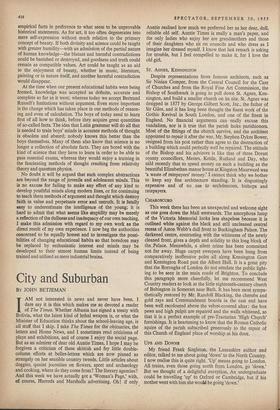City and Suburban
BY JOHN BETJEMAN Auntie realised how much we preferred her as her dear, dull, reliable old self. Auntie Times is really a man's paper, and the only ladies who enjoy her are grandmothers and those of their daughters who sit on councils and who dress as I imagine her dressed myself. I know that last remark is asking for trouble, but I feel compelled to make it, for I love the old girl.
ST. AGNES, KENNINGTON Despite representations from famous architects, such as Sir Ninian Comper, from the Central Council for the Care of Churches and from the Royal Fine Art Commission, the Bishop of Southwark is going to pull down St. Agnes, Ken- nington, and build a smaller church on its site. St. Agnes was designed in 1877 by George Gilbert Scott, Jnr., the father of Sir Giles, and it has long been thought the finest work of the Gothic Revival in South London, and one of the finest in England. No financial arguments can really excuse this vandalism, nor is it true that the parish lacks parishioners. Most of the fittings of the church survive, and the architect appointed to repair it after the war, Mr. Stephen Dykes Bower, resigned from his post rather than agree to the destruction of a building which could perfectly well be repaired. The attitude of the Bishop and his advisors is like that of three Dorset county councillors, Messrs. Kettle, Rutland and Day, who satd recently that to spend money on such a building as the beautiful Elizabethan manor house at Kingston Maurward was 'a waste of ratepayers' money.' I cannot think why we bother to keep any fine architecture standing. It is disgustingly expensive and of no use to archdeacons, bishops and ratepayers.
CHIAROSCURO
This week there has been an unexpected and welcome sight as one goes down the Mall westwards. The amorphous lump of the Victoria Memorial looks less shapeless because it is outlined white against the black and still =cleaned central recess of Aston Webb's dull front to Buckingham Palace. The darkened centre, contrasting with the whiteness of the newly cleaned front, gives a depth and solidity to this long block of the Palace. Meanwhile, a silent crime has been committed not far away. Huge carpet sweepers have been hung from comparatively inoffensive poles all along Kensington Gore and Kensington Road past the Albert Hall. It is a great pity that the Boroughs of London do not emulate the public light- ing to be seen in the main roads of Brighton. To conclude this paragraph more cheerfully, let me recommend West Country readers to look at the little eighteenth-century church of Babington in Somerset near Bath. It has been most sympa- thetically restored by Mr. Randoll Blacking, the cherubs and gold rays and Commandment boards in the east end have been well recoloured above the velvet-covered altar: the box pews and high pulpit are repaired and the walls whitened, so that it is a perfect example of pre-Tractarian 'High Church' furnishings. It is heartening to know that the Roman Catholic squire of the parish subscribed generously to the repair of this Church of England place of worship at his door.
UPS AND DowNs My friend Frank Singleton, the Lancashire author and editor, talked to me about going 'down' to the North Country. I now realise this is quite right. 'Up' means going to London. All trains, even those going north from London, go 'down.' But we thought of a delightful exception. An undergraduate could be travelling 'up' to Oxford or Cambridge, but if his mother went with him she would be going 'down.'


































 Previous page
Previous page